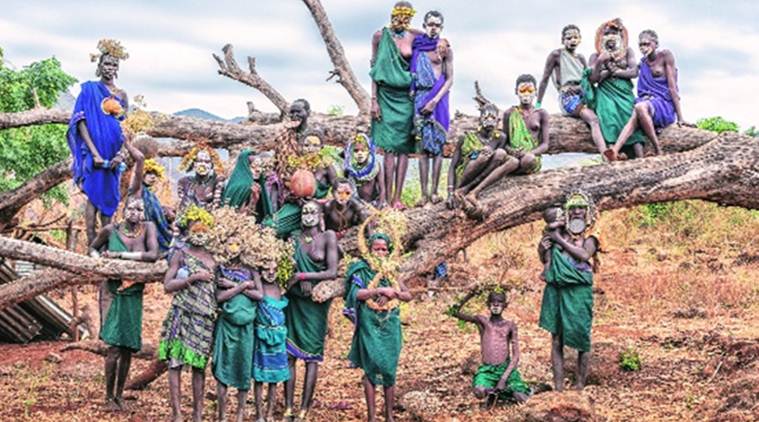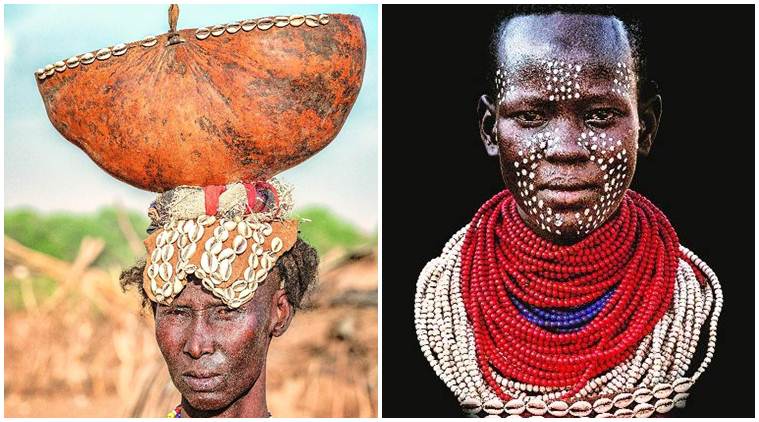On Tribal Trail
Wildlife biologist and photographer Latika Nath documents the life, culture and fashion of the tribes in Ethiopia’s Omo Valley

A group of Suri tribals
It was three years ago when wildlife biologist and photographer Latika Nath travelled to Ethiopia to capture a rare wolf on her camera. She photographed it in its natural habitat. Over time, her collection grew to include the pictures of the hyenas of Harar, the gelada baboons, the Abyssinian owl, the Rock Churches of Lalibela and Lucy, the several hundred pieces of bone fossils of the female ape discovered three decades ago. The tribes of the Omo Valley Ethiopia were not on her list. But when she found out about them, she decided to go to Omo and meet them. In multiple visits made over two years, Nath took over 60,000 photographs in Ethiopia, of which over 200 make the exhibition, “Omo – Where Time Stood Still”, at Delhi’s Bikaner House, supported by The Embassy of the Federal Democratic Republic of Ethiopia in New Delhi. These photographs also make a five-volume book series that will be launched at the Jaipur Literature Festival in January 2019.
“One part of the Omo valley is more accessible, that is where I had gone first, but I wanted to visit the other part too, where the Suri tribe lives, and that took me a year-and-a-half to organise. I was so bowled over by their way of life and the fact that it has existed for so long and is still carried on, that I wanted to document it,” says Nath, who is among the first women wildlife biologists in the country to work in the field of tiger conservation. For the past few years, she has been travelling and photographing the cat species of the world, including tigers, lions, cheetahs, jaguars, snow leopards and clouded leopards. She has also recently published a coffee table book, titled Hidden India, on the wilderness of India.
Living in and around the Mago and Omo National Parks, the eight tribes — Hamer, Bana, Mursi, Suri, Kara, Dassanech, Arbore and Nyangatom — are some of the oldest known to man and are only about 200,000 in toto. With development knocking at their doorstep, the tribes face changes they had never imagined. “Sugarcane and cotton plantation is on a rise in the country, hence there are dams built, along with access roads. But modernisation is yet to seep into their lives. They are also seeing more tourists in attires different from theirs’ and also vehicles. That change is slowly happening. Youngsters don’t want to wear lip plates and are gaining exposure now that they are visiting different markets,” she says.
The exhibition gives an insight into lives of the people, their culture, customs and lifestyle. It also brings to the fore the importance of guns in their lives. “There’s a lot of inter-tribe rivalry, and men take pride in how many people they’ve killed; they wear those scars with self-respect. War takes place over cattle and land. The guns came in because of the unrest in Sudan and Somalia,” she explains.
Their fashion is also a case study. Give them broken watch straps, gas pipes, bottle caps, plastic tubes, miscellaneous keys, or even a bicycle chain, and they will use them as fashion accessories. Coloured metal bullets are melted and made into bangles and earrings. Headdresses are devised from flowers, fruit and leaves, while beads are an essential part of the adornment and goat and cheetah skin is embroidered to create unique outfits. “The human body is used as a canvas for body art which was quite breathtaking to see. They like to look good and proud of the way they look and it comes through. It was also interesting to see their conditioning to accept pain and how it goes hand in hand with beauty,” she says, about the lip and ear plates worn by the tribals.
For Nath, documenting the tribes was a life-changing experience. She worked in temperatures over 45 degree celsius, drove hours each day to get to the villages, was shot at by an AK 47, hung out of planes, and lived in tents in the remotest villages. These stories will make it to her book.
“You come back a wiser person when you realise that you live on the same planet but there are many different worlds. The world as we know it is our reality, their reality is different,” she says.






















 Portrait of girls from the Suri tribe
Portrait of girls from the Suri tribe
No hay comentarios:
Publicar un comentario